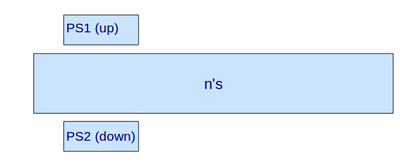Difference between revisions of "05/16/2011 coincidence test"
Jump to navigation
Jump to search
| Line 1: | Line 1: | ||
| − | |||
Set up like that: | Set up like that: | ||
| Line 35: | Line 34: | ||
|- | |- | ||
!PS1 | !PS1 | ||
| − | |<math>7513\ | + | |<math>7513\pm86.5</math>||60 min||<math>2.09\pm0.02</math> |
|- | |- | ||
!PS2 | !PS2 | ||
| − | |<math>9036\ | + | |<math>9036\pm95.1</math>||60 min||<math>2.51\pm0.03</math> |
|- | |- | ||
!PS1+PS2 | !PS1+PS2 | ||
| − | |<math>251\ | + | |<math>251\pm15.8</math>||60 min||<math>(6.9\pm0.4)\cdot 10^{-2}</math> |
|} | |} | ||
Latest revision as of 16:28, 16 May 2011
Set up like that:
the distance between PS and n's PMT is abot 50 cm
The voltages, thresholds and widths are as below. Note: I increased my thresholds for PS1 and PS2 from 80 mV up to 100 mV according to my previous calibration threshold line.
| PMT voltage, V | threshold, mV | discr. width, ns | |
|---|---|---|---|
| PS1 | -1000 | -100 | 50 |
| PS1 | -1000 | -100 | 50 |
| n's | -1500 | -200 | 10 |
First let's do the PS1+PS2 coincidence test
| counts | time | counts/sec | |
|---|---|---|---|
| PS1 | 60 min | ||
| PS2 | 60 min | ||
| PS1+PS2 | 60 min |
Second do the PS1+PS2+n's coincidence test
The ratio of (PS+PS2) rate to (PS+PS2+n's) rate is
